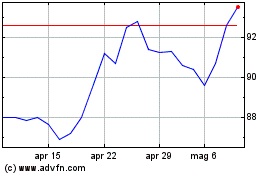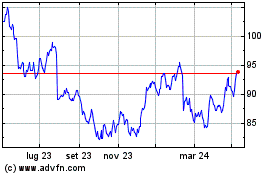Heineken 1st Half Profit Held Down on Higher Costs
29 Luglio 2019 - 2:43PM
Dow Jones News
By Saabira Chaudhuri
Higher costs held down profits in the first half of the year for
Heineken NV (HEIA.AE) even as the world's second-biggest brewer
sold more beer globally and launched its non-alcoholic Heineken
variant in the U.S.
Shares were trading 5.4% lower in afternoon trading in Amsterdam
after Heineken on Monday reported operating profits that missed
expectations. The Dutch brewer--which also owns Sol, Birra Moretti
and Tiger beer--blamed higher costs on aluminum prices and expenses
tied to the rollout of a new technology system, among other
things.
Net profit for the six months to June 30 was 936 million euros
($1.04 billion) compared with from EUR950 million the year
earlier.
Net revenue grew 5.6% on an organic basis to EUR11.45
billion.
Heineken's operating profit grew 0.3% organically to EUR1.78
billion, missing analyst estimates by 6.7%.
In an interview, Chief Financial Officer Laurence Debroux said
Heineken had also logged higher expenses tied to advertising for
the launch of its non-alcoholic beer Heineken 0.0 in the U.S.
"In the U.S. you always have to punch above your weight in terms
of advertising investment," she said.
Like its rivals Anheuser-Busch InBev S.A. (BUD) and Carlsberg AS
(CARL-A.KO), Heineken has been investing in non- and low-alcohol
brews as millennials across much of the developed world cut back on
drinking alcohol. The brewer said low and non-alcohol volumes
overall increased by a high-single digit percentage to 6.9 million
hectoliters. It said 48 of its brands now sell non-alcoholic
variants.
In the U.S., Heineken's eponymous brand continued to struggle
with beer volumes dropping by a mid-single digit percentage in the
half. The company said that was offset by the recent launch of
Heineken 0.0, which did well.
Heineken's exposure to the U.S. is far smaller than that of AB
InBev and Molson Coors Brewing Co. (TAP). That's holding it in good
stead at a time when many Americans are spurning mainstream lagers
for craft or imported brews as well as wine and spirits.
Globally, the company's beer volume rose 3.1% organically while
the Heineken brand saw volume rise 6.9%. Beer volumes climbed
strongly in the Asia Pacific region, Africa, the Middle East and
Eastern Europe. They declined in the rest of Europe which came up
against a tough comparison with the year-ago period that benefited
from the men's soccer World Cup and warmer weather.
Asia is becoming a bigger focus for brewers who hope to
accelerate efforts in the region's higher-growth markets at a time
of sluggish growth in many developed countries. In April, Heineken
closed its multibillion-dollar deal with government-controlled
China Resources Beer (Holdings) Co. (0291.HK), which gives it
access to a sprawling distribution network in the country.
AB InBev recently tried to publicly list its Asia arm saying
this would help it create a platform to do more acquisitions in the
region, but the world's biggest brewer scrapped the potential
listing after it couldn't get the price it was after.
On Monday, Ms. Debroux said Heineken's aluminum prices for the
first half of 2019 were locked in through hedges last year when
prices were very high, raising the brewer's costs.
Aluminum prices last year were hit by a range of factors
including higher tariffs, production curbs at the world's largest
alumina refinery in Brazil and a strike by workers at aluminum
giant Alcoa Corp. (AA).
Aluminum is priced in dollars, and the weak Brazilian real
further exacerbated the impact of higher aluminum costs for
Heineken in that key market, according to Ms. Debroux.
Heineken said its expenses for the half climbed 6.8% to EUR9.66
billion.
Despite all this, Heineken backed its guidance for the year.
Bernstein analyst Trevor Stirling said the second half of the year
"needs to be exceptionally strong" but added that this was
"doable." Heineken should see some of its headwinds ebb amid more
favorable hedges on aluminum and an easier comparison on expenses
tied to the technology rollout which began in the second half of
last year as well as on marketing expenses.
Ms. Debroux said part of the reason analyst estimates were so
off the mark was because Heineken offers guidance once a year
rather than on a quarterly basis.
--Anthony Shevlin contributed to this story
Write to Saabira Chaudhuri at saabira.chaudhuri@wsj.com
(END) Dow Jones Newswires
July 29, 2019 08:28 ET (12:28 GMT)
Copyright (c) 2019 Dow Jones & Company, Inc.
Grafico Azioni Heineken (EU:HEIA)
Storico
Da Mar 2024 a Apr 2024

Grafico Azioni Heineken (EU:HEIA)
Storico
Da Apr 2023 a Apr 2024
